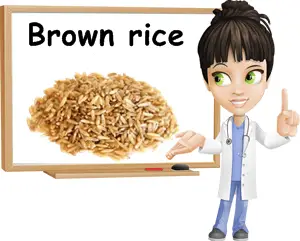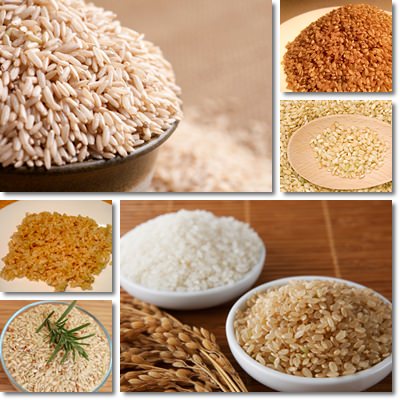When offered a choice between refined, white rice and whole brown rice, many people opt for the second and, in most cases, this is a wise decision. Brown rice has a considerably higher nutritional profile than the ordinary white rice and is thus superior to the latter because it stands a higher chance of providing more health benefits on the cardiovascular, digestive, nervous and immune system, but also bone and muscle health.
In addition to having good amounts of dietary fiber (7.85 g), brown rice is also a good source of B vitamins such as thiamine, niacin, pantothenic acid and vitamin B6. Moreover, it provides good amounts of important minerals such as manganese, magnesium, phosphorus and zinc. Brown rice is also a source of complex carbohydrates and essential amino acids with significant benefits for our health.

What is brown rice and where does it come from?
Interesting enough, brown rice is the father of white rice. After harvesting, most rice is cleared of an exterior layer called husk and brown rice is obtained. If another layer called bran and the germ of each seed are removed, then we are left with the least nutritious part of rice, commonly known as white rice. The husk, the bran and the germ are the healthiest parts of rice.
In the case of brown rice, maintaining the bran and germ (from which another rice seed will germinate) contributes to the health benefits of this cereal grain variety.
Other rice varieties such as red rice and black rice contain potent natural antioxidants called anthocyanins, responsible for the red and purple pigmentation of the seeds. These two varieties are considered far healthier than white and even brown rice because they reduce lipid oxidation and lower risks of atherosclerosis, contributing to artery health, protect cells against free radical damage and help in the prevention of chronic disease such as heart disease, diabetes and cancer.
Also see the benefits of red rice.
What are the benefits of Brown Rice?
Brown rice does have its benefits. See below the best 8 reasons why you should eat brown rice:
Reduces diabetes risks
According to researchers at Harvard University, eating at least two servings of brown rice per week can reduce the risk of developing type 2 diabetes with about 16%. Eating no more than half a cup of brown rice every day or so is safe even if you are suffering from diabetes because, unlike white rice, brown rice does not cause blood sugar levels to skyrocket but favors a more gradual rise aiming at stable blood glucose levels.

Good source of dietary fiber
Around 100 g of brown rice provides almost 8 g of dietary fiber. Why is fiber good? First of all, fiber adds bulk to stools and thus favors defecation (or pooping). By increasing the frequency of bowel movements, fiber-rich foods prevent constipation and related problems such as hemorrhoids.
Moreover, by promoting healthy, regular bowel movements, foods rich in fiber such as brown rice, oats, nuts and seeds help maintain colon health and, according to researchers, may even reduce colon cancer risks. Dietary fiber also prevents too much fat from being absorbed in the intestines and thus indirectly contributes to lower blood cholesterol levels and cardiovascular health.
Rich in selenium
According to Harvard Educational Review, brown rice contains 36% of the RDA of selenium, a mineral of crucial importance for good health. Selenium has a powerful antioxidant activity and is known to actively destroy certain types of tumor cells and repair damaged DNA. Moreover, it regulates iodine metabolism and is directly involved in the production of thyroid hormones. Because it regulates thyroid activity, selenium helps lower the risk of developing hypothyroidism (underactive thyroid disease) as well as supports the immune function.
High content of manganese
The percentage of manganese in brown rice varies between 88% and 180%, depending on variety, brand and processing. Manganese, a powerful antioxidant-mineral, is a part of an enzyme called superoxide dismutase. By means of this enzyme, manganese prevents free radical damage and cancer-causing cell mutations.
Protects against heart disease
In addition to high amounts of dietary fiber which helps reduce cholesterol levels, brown rice offers additional protection against heart disease as a result of its plant lignan content. Lignans are natural plant chemicals with powerful antioxidant and anti-inflammatory activity which contribute to heart and artery health.
Rich in phytochemicals
Brown rice is a great source of natural antioxidant and anti-inflammatory compounds known as phytochemicals which play a part in the prevention of atherosclerosis, inflammatory diseases and even cancer.
Lower risks of childhood asthma
According to research, children who eat a lot of whole grains such as brown rice, oat, barley, rye, amaranth, quinoa, buckwheat and so on have a 50% lower risk of developing asthma compared to children who have an extremely low intake.
Promotes healthy bones and strong teeth
Brown rice provides 21% of the RDA of magnesium, a mineral which favors calcium absorption in bones and ensures healthy muscles, heart included. Magnesium is stored in bones and physically contributes to bone and teeth health.
It’s gluten free
Brown rice is gluten-free, making it ideal for those of you who are struggling with gluten sensitivity or intolerance, Coeliac disease and even wheat allergy. Gluten is a protein in some cereal grains such as wheat. When ingested, it may cause some people’s immune system to overreact and attack the small intestine in an attempt to remove it as it mistakenly considers it a cause for disease. In such cases, a gluten-free diet is imperative for good digestive and overall health. Other gluten-free options include amaranth, corn or maize, buckwheat and other rice varieties such as white, red, purple and black rice.
Also see the benefits of black rice.
Conclusion
Overall, brown rice is a far better choice than white rice. However, due to the vast use of pesticides on every crop possible, from pineapple to rice, eating fruit skins or whole grains may pose some health risks. After all, skins, husks, rinds and peels are the first exposed to pesticides and ingesting them may not be very good in the long run. For this reason, it might be best to only purchase quality brands, preferably organic, from brands with good production ethics.
